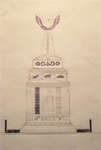"Exhibit Walks Through Native Life"
- Publication
- Brantford Expositor, 25 Jan 1991
- Full Text
- Exhibit walks through native lifeBy Cindy Jacobs, For The Expositor
In The Steps of Our Ancestors is an exhibition of North American Indian footwear that reflects one of the few surviving aspects of native culture.
At the Woodland Cultural Centre until March 31, the exhibit by the Bata Shoe Museum Foundation and the Ontario Crafts Council shows that footwear of the Indian people has kept the spirit alive throughout the walk of time.
Although many of the younger generation have slowly integrated into modern society, the transition of Indian costume and footwear has been steadfast throughout history. Not only did the moccasin provide protection against the harshness of reality and Mother Earth, the ornate designs often indicated status and tribal affiliation. Frequently, the fitted designs were brought to mind by visions from the Creator and were believed to possess special powers.
Although footwear protected feet, it also reflected the native people's way of life and acknowledged their beliefs.
Because of the temperate climate, the natives of the Northwest coast wore soft-soled moccasins decorated with clan or tribe emblems. They wore these when hunting small game inland as they were mostly fishermen and whalers.
The caribou hunters also wore soft-soled moccasins made from moose or caribou hide trimmed with beaver, rabbit or wolf fur. The Hudson's Bay Co. led the way for the natives to incorporate trading goods around the 18th century.
Eastern footwear made from soft deer skin was also in the form of the moccasin, beaded with floral design as the result of the influence of European missionaries.
Being one of the first people to have contact with Europeans they also were introduced to velvet, silk ribbons and woven fabrics around the 19th century. They generated a tourist trade with the new settlers and were also the first nations to step into colonial politics.
In some areas, due to climate and treacherous mountain land, the Indians were forced to live a nomadic life in order to seek food.
The Plains people, as they were known, adopted their own design which varied between the minimal of abstract floral and geometric patterns.
Unequalled to these people was the side-seamed moccasin made of one piece of material (deerskin or moosehide) folded around the foot and stitched along one side.
The buffalo hunters wore a two-piece constructed shoe, rather than a moccasin, that was made from tough rawhide soles attached to soft tanned uppers. They also used beads and porcupine quills to design reflections of natural objects and ritual beliefs.
Natives of the southwest were inclined to be farmers and skilled workers because of the desert-like region they inhabited.
Although their native craftmanship benefitted their growth (in weaving, pottery and silversmithing), they also raised sheep and goats. The hostile environment indicated that they had to wear a style of footwear that protected the foot and leg. Typical was the boot with a hard, turned-up sole attached to a deerskin upper that wrapped around the leg.
Coloring, extracted from natural materials, mainly the earth, plants and animals, were added as a decorative style to the footwear.
In each case the soft soled shoe or moccasin was beneficial in quietly stalking game.
Although native footwear survived the transition of the European people, many art forms and cultural traditions were drummed out of existence. Native footwear survived the stitches of outside influences. Moccasins were sewn together using new concepts and man-made materials and escaped the threads of manufacturing.
Today true moccasins are hand sewn, hand beaded and manufactured with pride. True native footwear was enhanced by the European influence but no shoe today can match the authenticity or beauty of native footwear.
A belief among the natives is that Mother Earth guides her people throughout the walk of life, so do the Indian women of our nation. They are responsible for maintaining traditions.
Their responsibility for preparing materials for sewing and decorating tribal dress and moccasins is acknowledged by the fact that The Bata Shoe Museum attributes In The Steps of Our Ancestors to generations of native women.
The exhibition reflects the changes that continue to affect the lives of native people. More importantly, it shows their determination to keep native culture alive.
The Bata Shoe Museum has collected a comprehensive array of North American footwear from pre-Columbian (1840-1910) sandals to modern award-winning moccasins from the Decorated Moccasin competition that the Bata Shoe Museum sponsored in 1987.
Cindy Jacobs is a freelance writer.
- Creator
- Jacobs, Cindy, Author
- Media Type
- Newspaper
- Item Types
- Articles
- Clippings
- Description
- "In the Steps of Our Ancestors is an exhibition of North American Indian footwear that reflects one of the few surviving aspects of native culture."
- Date of Publication
- 25 Jan 1991
- Subject(s)
- Personal Name(s)
- Monture, Adrienne ; Harris, Judy ; Walford, Jonathan ; Hopkins, Ada.
- Corporate Name(s)
- Woodland Cultural Centre ; Bata Shoe Museum Foundation ; Ontario Crafts Council ; Hudson's Bay Company.
- Local identifier
- SNPL002440v00d
- Language of Item
- English
- Geographic Coverage
-
-
Ontario, Canada
Latitude: 43.1334 Longitude: -80.26636
-
- Creative Commons licence
 [more details]
[more details]- Copyright Statement
- Public domain: Copyright has expired according to Canadian law. No restrictions on use.
- Copyright Date
- 1991
- Copyright Holder
- Brantford Expositor
- Contact
- Six Nations Public LibraryEmail:info@snpl.ca
Website:
Agency street/mail address:1679 Chiefswood Rd
PO Box 149
Ohsweken, ON N0A 1M0
519-445-2954



